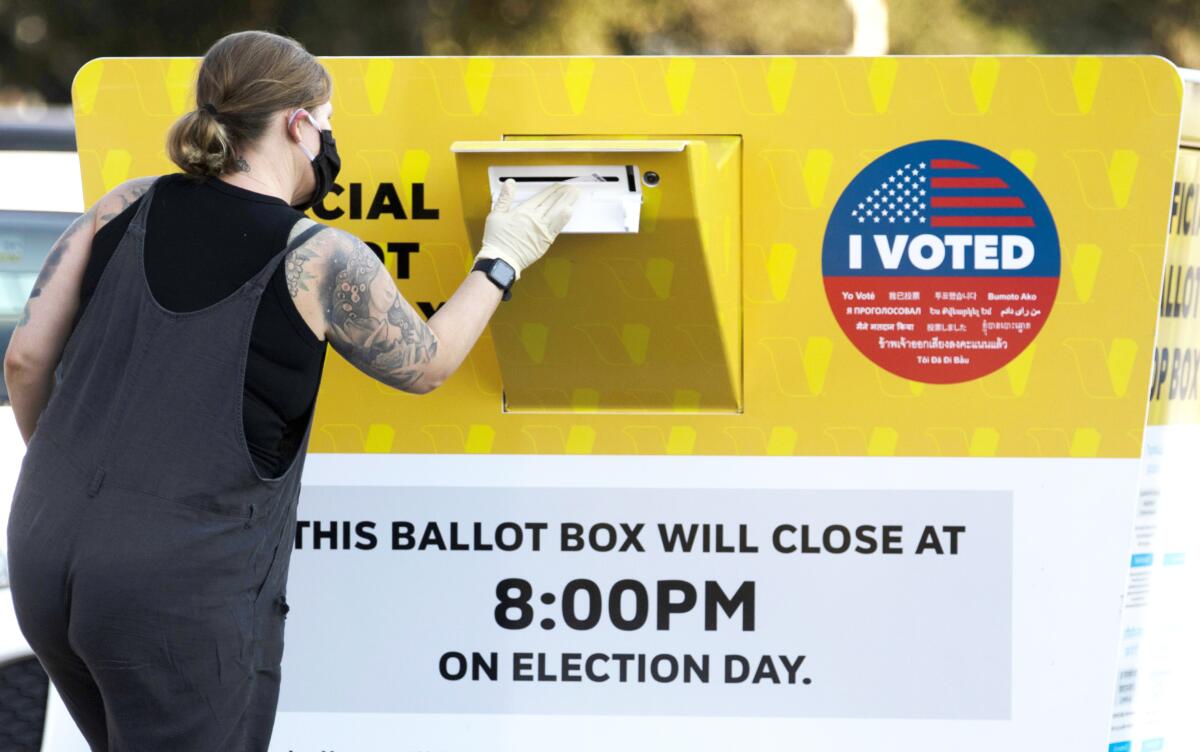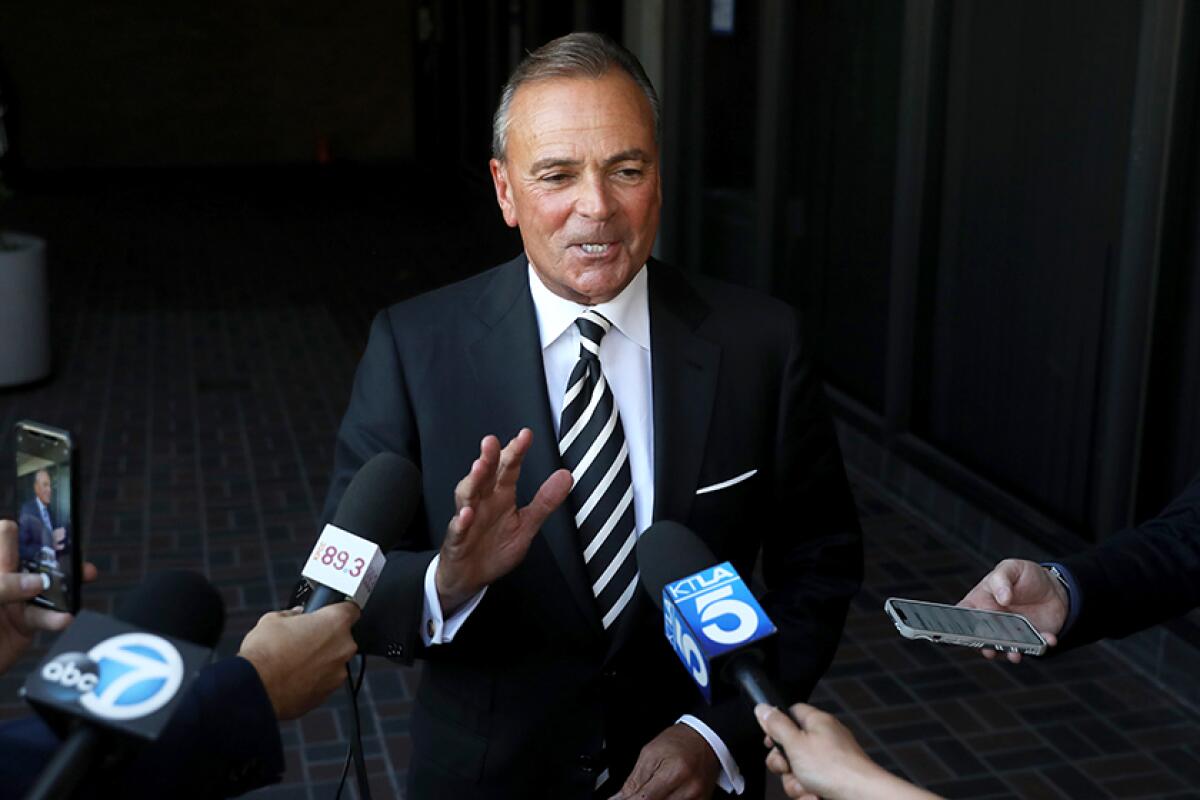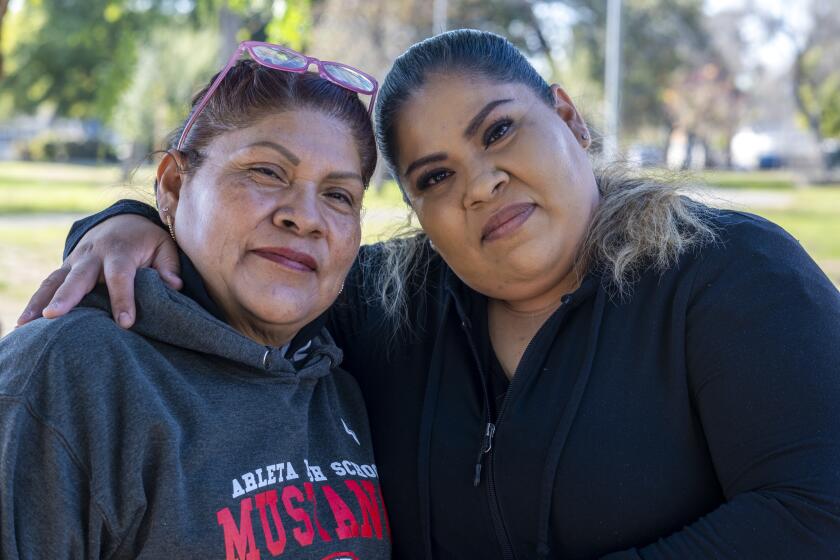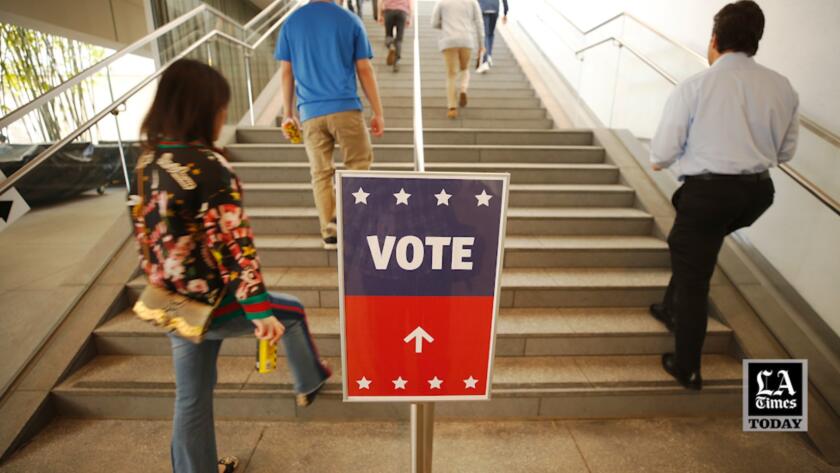California has made voting easier, but regular voters still skew white and old, poll finds

- Share via
Voting in California has never been easier.
Eligible residents can get help in 10 languages. Ballots are sent to registered voters’ homes. They have a month to drop a ballot off in boxes around their municipality. That’s on top of multiple days of voting in person and the ability to register to vote up until the last minute.
Despite all that, the people who vote most often remain older, whiter and wealthier than most Californians, according to a new survey from UC Berkeley’s Institute of Governmental Studies.
Just under 4 in 10 of the state’s registered voters are what Berkeley defined as regular voters — those who have cast ballots in at least five of the last seven statewide elections. Berkeley researchers determined the frequency of voting by verifying the voter histories of more than 6,000 registered voters whom they surveyed.
That pool of regular voters is 71% white, a share that is significantly larger than the white share of registered voters. Latinos, at 14%, were underrepresented among regular voters. Those frequent voters were also disproportionately over the age of 50.
Roughly another 4 in 10 registered voters are either infrequent voters — those who have voted only once or twice in the last seven elections — or people who haven’t voted at all despite being registered. That group is about one-third white but about 40% Latino.
Infrequent voters are also much more likely to be young, to be renters and to be unmarried, Berkeley found.
Registered voters who identified as Asian or Pacific Islanders were also more likely to be infrequent voters or to not have cast a ballot in the last seven elections.
Black voters were represented about equally in each group.
Asked why they didn’t vote more often, registered voters who cast ballots infrequently or never cited a lack of information or interest. About 3 in 10 said they didn’t know enough about the candidates or the issues to vote. A similar share said they were “not that interested” in the contests.
About 1 in 4 registered voters who didn’t vote frequently or hadn’t voted at all said they felt their vote didn’t matter much or that no matter how they voted, special interests and big money controlled politics.
Fewer than 1 in 10 said that voting was inconvenient or confusing.
By contrast, those who vote regularly said they did so to “stand up for the candidates and issues I believe are important” (65%), “to influence the direction of state and local government” (64%), or because voting is “an important civic duty” (62%).
The poll results “dramatize the differences that we knew existed. The differences are just profound. ... It’s two very different worlds,” said Berkeley IGS poll director Mark DiCamillo.
“The state has invested in trying to make voting easier. That’s what the state is doing when it’s sending out ballots early,” DiCamillo added.
“What still needs to happen is the communication of the value of voting to voters. And that’s the task ahead.”
The prospect of Latino voters coming to the polls in numbers proportional to their 40% share of the state’s population and transforming local and state races has tantalized activists and analysts for years. But it has not come to pass.

The latest example came last year when Rick Caruso ran for Los Angeles mayor.
Part of his strategy rested on the idea that he could engage working-class Latino voters with an army of paid door-knockers and messages about public safety, corruption and homelessness.
Polls showed that those issues potentially could mobilize voters, and Caruso’s large fortune gave him tens of millions of dollars to spend on televised advertising to drive home his message.
Nonetheless, turnout lagged in neighborhoods that were majority Latino, one reason Caruso lost the race to then-Rep. Karen Bass by 10 points.
California has been relatively successful in getting people registered to vote. The state has just under 22 million registered voters, 82.3% of the eligible population, according to the most recent statistics from the secretary of state’s office. A decade ago, 76% of the eligible population was registered, and a decade before that, 69%.
California’s level of registered voters is significantly higher than the nationwide average, which was 69% in 2022, according to the Census Bureau.
Because of relatively low turnout, Latino representation in elected office in Los Angeles lags — a gap at the heart of the audio leak scandal.
But the state has lagged in actual voter turnout.
In the 2022 midterm elections, California’s turnout was 43% of the voter-eligible population, which ranked the state 35th in the country, according to statistics compiled by the U.S. Elections Project, based at the University of Florida.
The state’s efforts to increase voter participation have included a law adopted in 2021 requiring that every voter be mailed a ballot.
A large majority of registered voters, 63%, say voting is easier now that ballots are sent a month before election day, the Berkeley poll found. Just 27% said the new law had caused no change in the ease of voting, and 4% said voting was harder.
Reflecting the partisan division nationwide over voting, 77% of Democrats said that it’s now easier to vote, while among Republicans, 36% said so and 49% said the law had not changed how easy it is to vote.
About two-thirds of registered voters said they thought it was the state’s responsibility to expand voter outreach among underrepresented groups. About the same number of registered voters said they’d back devoting more state money to this mission.
Candidates for statewide office next year — including in the race to replace Sen. Dianne Feinstein — have already emphasized the importance of turning out voters who have either been ignored or are not in parts of the state that receive as much attention.
Political consultants in California say, however, that it’s a tall order to engage and excite potential voters who are less well off and are concerned with the tasks of getting through the day.

“It used to be if you’re able to leave your job and go vote that was considered a luxury,” said Democratic consultant Michael Trujillo, who has advised local candidates in races all across Los Angeles for years. Recently he helped Imelda Padilla prevail in a City Council special election in the San Fernando Valley where turnout barely broke single digits.
“So how did we eliminate that? It became about absentee balloting and making the postage free.”
“But I think what it’s coming down to is the luxury of thought. It’s the luxury of being able to think about who your next elected [representative] should be and being able to compile the information to make an informed choice. Many of our working class or poverty-stricken families, which may be registered or are able to register, they just don’t have time to think about it. They’re working two jobs there.”
The poll, which was sponsored by the Evelyn and Walter Haas, Jr. Fund, asked voters if they had participated in at least one of seven political acts or activities last election cycle, including posting on social media about candidates, donating to a political cause or wearing a button. Nearly 60% of respondents said they participated in one of these activities.
Like the act of voting itself, being politically active was more common among those who are older, wealthier and whiter. Two-thirds of white voters fit the profile of being politically active compared with half of Latino voters and just under half of Asian American voters.
The Berkeley IGS poll was conducted online in English and Spanish from July 20 to July 25 and surveyed 6,164 registered voters statewide.
The poll sample was weighted to match census and voter registration benchmarks. Because of weighting, precise estimates of the margin of error are difficult, but the results are estimated to have a margin of error of 2 percentage points in either direction for the full sample.
Los Angeles Times Senior Editor David Lauter contributed to this report.
- Share via
Watch L.A. Times Today at 7 p.m. on Spectrum News 1 on Channel 1 or live stream on the Spectrum News App. Palos Verdes Peninsula and Orange County viewers can watch on Cox Systems on channel 99.
More to Read
Sign up for Essential California
The most important California stories and recommendations in your inbox every morning.
You may occasionally receive promotional content from the Los Angeles Times.













